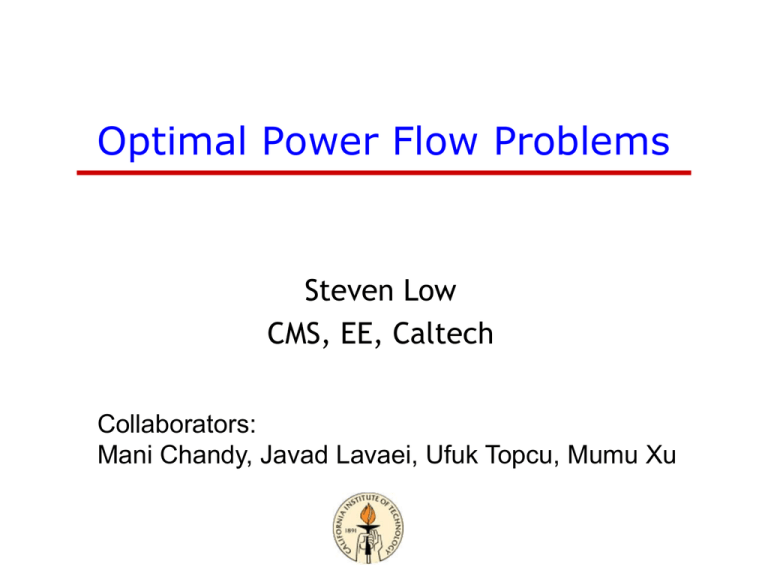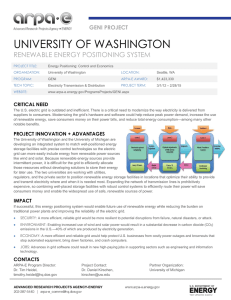
Optimal Power Flow Problems
Steven Low
CMS, EE, Caltech
Collaborators:
Mani Chandy, Javad Lavaei, Ufuk Topcu, Mumu Xu
Outline
Renewable energy and smart grid
challenges
Optimal power flow problems
Zero duality gap: Javad Lavaei, SL
OPF with storage: M. Chandy, SL, U. Topcu,
M. Xu
Renewable energy is exploding
... driven by sustainability
... enabled by investment & policy
Global investment in renewables
average : 2B people not electrified
Source: Renewable Energy GRS, Sept 2010
Renewable energy is exploding
... driven by sustainability
... enabled by investment & policy
Global capacity growth
2008, 09
fossil fuels renewables
53%
47%
average : 2B people not electrified
Source: Renewable Energy Global Status
Report, Sept 2010
Summary
Renewables in 2009
Account for 26% of global electricity capacity
Generate 18% of global electricity
Developing countries have >50% of world’s
renewable capacity
World: +80GW renewable capacity (31GW hydro,
48GW non-hydro)
China: +37GW to a total renewable of 226 GW
In both US & Europe, more than 50% of added
capacity is renewable
Generation
Transmission
Distribution
Load
Some challenges
1. Increase grid efficiency
2. Manage distributed generation
3. Integrate renewables & storage
4. Reduce peak load through DR
Technical issues
a) Wide range of timescales
b) Uncertainty in demand and supply
c) SoS architecture and algorithms
Challenge 1: Wind & Solar are Far from People
• Need
transmission
lines
Legend:
• Wind
• People
Source: Rosa Yang
© 2010 Electric Power Research Institute, Inc. All rights reserved.
8
Challenge 1: grid efficiency
Must increase grid efficiency
5% higher grid efficiency = 53M cars
Real-time dynamic visibility of power
system
Now: measurements at 2-4 s timescale
offers steady-state behavior
Future: GPS-synchronized measurement at
ms timescale offers dynamic behavior
But: lack theory on how to control
Source: DoE, Smart Grid Intro, 2008
Challenge 2: distributed gen
2-3x more efficiency, less load on trans/distr
Source: DoE, Smart Grid Intro, 2008
Challenge 3: uncertainty of renewables
High Levels of Wind and Solar PV Will
Present an Operating Challenge!
© 2010 Electric Power Research Institute, Inc. All rights reserved.
12
Source: Rosa Yang
Challenge 3: storage integration
Customer
Transmission & Sub-transmission
Customer
Generation
Storage
Transmission & Sub-transmission
Storage
• Where to place storage systems?
• How to size them?
• How to optimally schedule them?
Source: Mani Chandy
Challenge 4: High peak
National load factor: 55%
10% of generation and
25% of distribution
facilities are used less
than 400 hrs per year, i.e.
~5% of time
Demand response can
reduce peak
Feedback interaction
between supply & demand
Source: DoE, Smart Grid Intro, 2008
Issue c: SoS architecture
Power network will go through similar
architectural transformation in the next couple
decades that phone network is going through now
Tesla: multi-phase AC
?
Deregulation
started
Enron, blackouts
1888
1876
Both started as natural monopolies
Both provided a single commodity
Both grew rapidly through two WWs
Bell: telephone
1980-90s
2000s
1980-90s
Deregulation
started
1969:
DARPAnet
Convergence
to Internet
Issue c: SoS architecture
... to become more interactive, more distributed,
more open, more autonomous, and with greater
user participation
What is an architecture
theory to help guide the
transformation?
... while maintaining security & reliability
Outline
Renewable energy and smart grid
challenges
Optimal power flow problems
Zero duality gap: Javad Lavaei, SL
OPF with storage: M. Chandy, SL, U. Topcu,
M. Xu
Optimal power flow (OPF)
OPF is solved routinely to determine
How much power to generate where
Pricing
Parameter setting, e.g. taps, VARs
Non-convex and hard to solve
Huge literature since 1962
In practice, operators often use heuristics to
find a feasible operating point
Or solve the (primal) problem to find a local
minimum
Optimal power flow (OPF)
min
Quadratic generation cost
c g
i
iG
i
over
u : g i , gˆ i , i G; Vi ,Vˆi , i G D
subject to
g imin g i g imax
i G
gˆ imin gˆ i gˆ imax
i G
vimin | Vi | vimax
i G D
Vi I *i g i j gˆ i
V I * d j dˆ
i G
i i
i
V YI
i
iD
supply = demand
Kirchoff Law
Our proposal
Solve a convex dual problem (SDP)
Very efficient
Recover a primal solution
Check if the solution is primal feasible
If so, it is globally optimal
A sufficient condition (on the dual
optimal solution) for this to work
Our proposal
All IEEE benchmark systems turn out to
(essentially) satisfy the sufficient
condition
14, 30, 57, 118, 300 buses
All can be solved efficiently for global
optimal
Dual OPF : SDP
Linear function
subject to
Our proposal
Solve Dual OPF for ( x opt , r opt )
If dual optimal value is , OPF is
infeasible
Compute [U1T U1T ]T in the null space of
Compute a primal solution
If it is primal feasible, it is globally
optimal
Sufficient condition
Theorem
opt
Suppose the positive definite matrix A
has a zero eigenvalue of multiplicity 2.
The duality gap is zero
V opt is globally optimal
Proof idea
Proof idea
Re{Vk I k* } trace{YkUU T }
Im{Vk I k* } trace{Y kUU T }
Proof idea
Semidefinite program
(convex)
Proof idea
Outline
Renewable energy and smart grid
challenges
Optimal power flow problems
Zero duality gap: Javad Lavaei, SL
OPF with storage: M. Chandy, SL, U. Topcu,
M. Xu
OPF + storage
Without battery: optimization in each
period in isolation
Grid allows optimization across space
With storage: optimal control over finite
horizon
Battery allows optimization across time
Static optimization optimal control
How to optimally integrate utility-scale
storage with OPF?
Simplest case
Single generator single load (SGSL)
Main simplification
g (t ) r (t ) d (t ),
t 1,...,T
SGSL problem
T
min
g (t )0
s. t.
c( g (t ), t ) h(b(t )
hT (b(T ))
t 1
b(t ) b(t 1) d (t ) g (t )
all the complications
0 b(t ) B
g (t ) 0
Example: time-invariant
If battery constraint inactive
T
g (t )0
s. t.
b(t ) b(t 1) d g (t )
min
t 1
1 2
g (t ) ( B b(t ))
2
Optimal generation decreases linearly in
time
“nominal generation”
g (t ) T 1 t
Optimality:
g (t ) T 1 t
marginal cost
of generation
unit-cost-to-go
of storage
SGSL case
With battery constraint
T
g (t )0
c( g (t ), t ) h(b(t )
s. t.
b(t ) b(t 1) d (t ) g (t ) [0, B]
min
hT (b(T ))
t 1
Optimal policy anticipates future
starvation and saturation
Optimal generation has 3 phases
Phase 1: Charge battery, generation decreases
linearly, battery increases quadratically
Phase 2: Generation = d (phase 2 may not exist)
Phase 3: Discharge battery, generation decreases
linearly, battery decreases quadratically
Key assumption
Forecast for Cal ISO, 27 September, 2009
Optimal solution: case 1
Optimal generation cross demand curve
at most once, from above
Optimal solution: case 2
Optimal generation cross demand curve
at most once, from above





